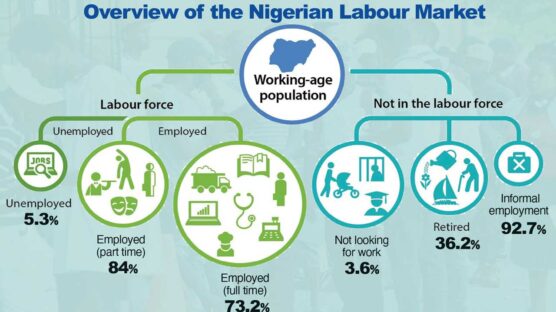
The National Bureau of Statistics (NBS) has said that at least 86 per cent of 88.9 million Nigerians in the labour force lacked post-secondary education in 2023.
This was revealed in the latest Nigeria Labour Force Survey (NLFS) released by NBS in its yearly report for 2023. According to the report, about 76.6 million Nigerians in the labour force are without post-secondary qualifications, highlighting a significant gap in educational attainment that could hinder Nigeria’s economic development.
This alarming figure highlights the nation’s ongoing struggles to equip its workforce with the advanced skills needed in the modern economy. In the report, only 12.3 million persons (14 per cent) of the labour force have received post-secondary education. This divide presents significant challenges for Nigeria’s competitiveness on the global stage.
The report also explained that the data reflected the disparities in access to higher education and technical training, which are crucial for fostering innovation and enhancing productivity.
The 76.6 million Nigerians include those in the labour force with “no education”, “primary education” and “secondary education.” A striking feature of the data is that 24.3 million people in the labour force (81.6 per cent) have no formal education. Despite this, 79 per cent of these individuals are employed, leaving an unemployment rate of just 3.2 per cent.
This data suggests that those with no education may be engaged in informal sectors, such as agriculture, trading or other low-skill jobs that do not require formal qualifications.
These jobs may offer lower wages and fewer opportunities for upward mobility but are essential in providing livelihoods for a large portion of Nigeria’s population.
The report also stressed that the labour force with primary education comprised 23.1 million individuals, with a labour force participation rate of 65.6 per cent. The employment rate for this group is 62.9 per cent, and rises slightly to 4.1 per cent.
This marginal increase in unemployment compared to those with no education may be attributed to a greater reliance on formal sectors for employment, where the demand for primary education may not be sufficient for highly skilled jobs.
The largest segment of the labour force, totalling 29.2 million people, has secondary education. With a labour force participation rate of 77.7 per cent and an employment rate of 72.5 per cent, this group has a higher unemployment rate of 6.7 per cent.
This suggests that while secondary education opens doors to a wider range of job opportunities, there remains a mismatch between the skills acquired at this level and the job market’s requirements.
A critical observation in the data is that individuals with post-secondary education, totalling 11.7 million, have the highest labour force participation rate at 87.9 per cent.
Despite this high participation rate, 9.4 per cent of this group remains unemployed, a significantly higher rate compared to other educational categories. This trend points to a significant challenge for Nigeria’s labour market. While post-secondary education is typically associated with better employment prospects, the data reveals that a substantial portion of these individuals struggle to find jobs.
Interestingly, the group with postgraduate education has the lowest unemployment rate at 3.8 per cent. While only 606,020 individuals fall into this category, the employment rate is high at 87.3 per cent, reflecting that advanced degrees often lead to better job security and higher-paying positions. Postgraduates are more likely to find employment in specialised, professional fields, where advanced qualifications are typically required.






